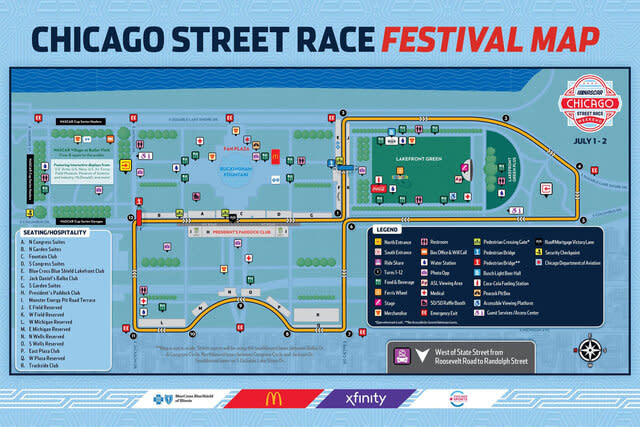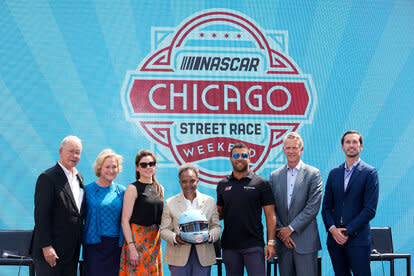NASCAR's Chicago Street Race Isn't Windy City's First Foray into Racing
Any proud native of Chicago will gladly tell you that, when it comes to first-of-its-kind accomplishments, the "Second City" is anything but. Throughout its history, Chicago has stood as a beacon for innovation and change, welcoming workers, dreamers, and artists striving to turn ideas into reality.
Where’s the proof, you ask? How about in the first skyscraper? In 1884, the 10-story Home Insurance Building was constructed at the intersection of LaSalle and Adams streets. The first refrigerated rail car? It was operated out of Chicago. How about the the TV remote, start of America’s “Historic Route 66,” or even the first nuclear chain reaction that ushered humanity into the Atomic Age? You guessed it – the Windy City was the setting for them all. Ingenuity runs so deep for Chicagoans that, when sewage in Lake Michigan threatened to proliferate waterborne diseases throughout Chi-town in 1900, tirelessly working public services engineers figured out a way to reverse the flow of the Chicago River, potentially saving thousands of lives. Second City’s citizens even flipped the script on pizza, reordering a pie’s layers at Pizzeria Uno in 1943 to make the long-overlooked sauce the dough’s true boss.
That’s why when NASCAR brass began conceptualizing a first-of-its-kind street race for the Xfinity Series and Cup Series, Chicago stood out as the target contender. It’s grid of sharp turns, long straightaways and landmarked-peppered streets present the perfect opportunity for NASCAR and its talented crop of wheelmen to electrify the city.

Chicago Street Race Festival Map Photo: Nascar
That said, this weekend’s much-anticipated street race won’t be the first time speed took the Windy City by the storm. In fact, Chicago graciously hosted the first automobile race to ever take place in the United States.
After being inspired by a French event in 1895 where competitors raced from Paris to Bordeaux, H.H. Kohlsaat knew that he had to bring a similar exhilarating experience to Chicago and, as the owner of the renowned Chicago Times-Herald Newspaper, he knew an event of its caliber would have his readers salivating for more. Once the race date was locked in for Thanksgiving Day, the challenge, according to NASCAR historian Ken Martin, as featured in a report by NBC 5 Chicago, was how to prepare for and contend with Mother Nature.
“Chicago was greeted by about six or seven inches of snow that morning, so, you can understand how primitive the road conditions might have been,” Martin told the outlet.
Like a barrage from Muhammed Ali – a once long-term resident of the South Side along with former President Barack Obama – the winter storm relentlessly pounded Chicago but, as was the case when The Great Fire of 1871 razed the then-34-year-old city to smoldering embers, the city and its people would figure out a plan to ensure that show would go on. Course designers devised a way to evade the worst of the weather by shifting around the original idea that would’ve seen drivers race to Milwaukee and back.
“Back then, who knows how long it would have taken,” JoJo Galvan, a historian at the Chicago History Museum, told NBC 5 Chicago. “Eventually, it got cut down to Chicago, south side, to Waukegan. Day of the race, because of the blizzard, it got cut down from Chicago south side to Evanston and back.”

Everything You Need to Know About NASCAR's Chicago Street Race
For those familiar with the area, that might seem like a dramatically shortened distance, but that doesn’t mean it wasn’t an arduous feat. Only two of the six vehicles that started the race completed it, and the winner, J. Frank Duryea, clocked an exhausting time of more than 10 hours to finish the race.
“The average speed for the 54 miles was only seven miles per hour,” Martin revealed. “So, if you’re a brisk walker, you can probably make seven miles in an hour.”
For comparison, there will be 40 vehicle entries for NASCAR’s debut street race and, according to the Chicago Tribute, Dale Earnhardt Jr. said drivers piloting today’s Next Gen car should top out at a blistering 140 miles per hour on straightaways like DuSable Lake Shore Drive while tight, hairpin corners will slow the field down to just 40 mph.
With NASCAR gifting its fans the first ever street race in the league’s 75-year history, the significance of the moment is not lost on Martin.
“In any sporting competition or any civic competition, being first means something," explained Martin. "It means a lot. So, if Chicago is the birthplace of auto racing, it deserves an important place in our history."
Be sure to tune into NASCAR's Chicago Street Race, Sunday, July 2 at 5:30 p.m. ET on NBC as well as Peacock.

